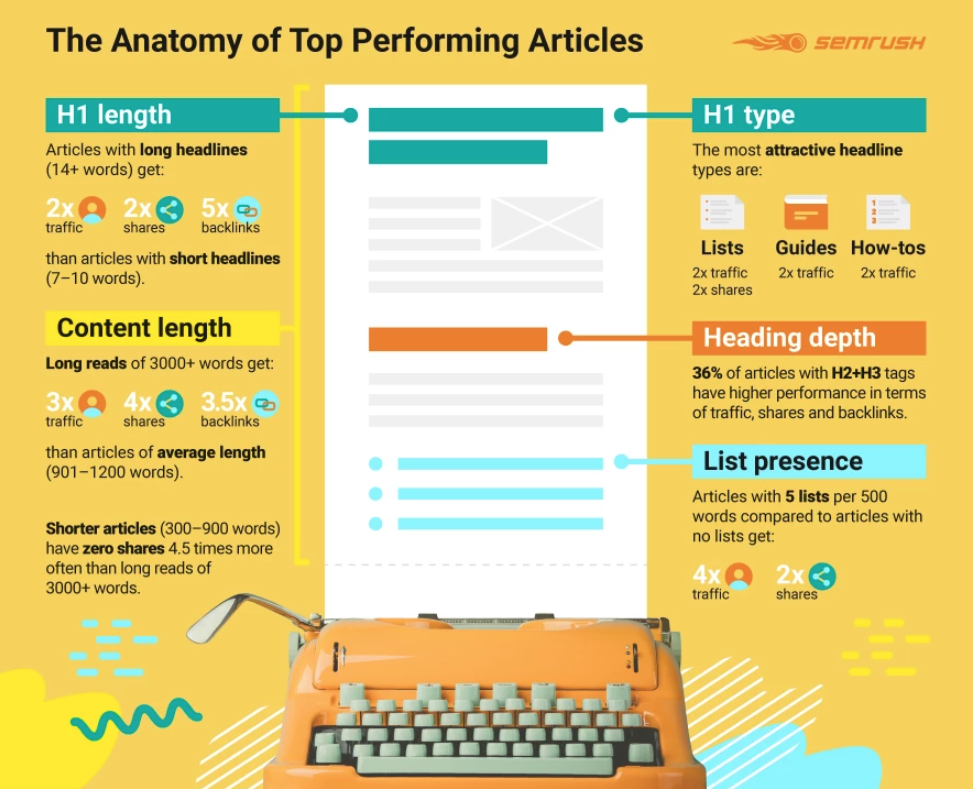Writing great content that generates traffic, engagement, backlinks, shares and leads is the holy grail of content marketing.
While there is still no simple recipe, one of the great benefits of the massive amount of content produced and the growth of analytical tools to review results has been a much better understanding of what works and what doesn’t.
We now know with more clarity than ever how to write great content.
Writing Great Content Means Lots Of Writing
As part of its State Of Content Marketing 2019 Global Report, SEMrush analysed more than 700,000 articles from domains that had between 50,000 and 500,00 sessions per month.
The results were not great for lovers of short articles. It showed pages and blogs of more than 3,000 words getting 3x the traffic, 2x the shares and 3.5x more backlinks than articles of average length. Short articles (less than 200 words) are not shared at all 4.5x more often than long reads.
READ MORE: Five Newsroom Principles To Supercharge Your Content Strategy
The length of headlines is also critical to engagement. Articles with long headlines (14+ words) get 3x more traffic, 2x more shares and 5x more articles with short headlines (7-10 words).
The reason for the popularity of long reads is contested by it is safe to assume that as the sheer number of content pieces grows, readers are increasingly being more selective and taking deeper dives.
The length of a ‘long’ article continues to get longer as well. In 2014, HubSpot tallied the averages of all of its 6,000+ blog posts and derived that there is a “positive correlation between high performing pages within organic search and word counts over 2,250 words”. Just five years ago SEMRush’s sweet spot rested right between 2,250 and 2,500 words.
If the thought of writing 3,000 (or 2,500) words makes you draw a deep breath, thankfully there is an alternative view.
According to research done by popular blogging platform, Medium, the ideal length for blog posts is 1,600 words (or seven minutes of reading). This result is based on an analysis of the “average total seconds spent on each post and compared this to the post length.” Their research found that up to the seven minute/1,600 wordmark, readers average time spent looking at the post increased, plateauing at the seven-minute mark, and quickly declining after that point.
While length is important, how you use it is also critical. The most important thing to remember is that quality content is what really matters. 5,000 words of dribble will not get anywhere near the result of 500 words of highly-targeted, useful content.
Are Listicles Still Important?
There is a reason listicles have spread like a rash across the internet. They work. According to SEMrush, listicles get the most shares and traffic (up to 2x more than other blog types), followed by guides and “how to” articles.
Why do they work? They allow our brain to digest information in a very digestible way. Modern media assaults us with a never ending stream of content. Our brains simply do not have the capacity to sort through the massive volume of information and store in a useful place for easy recall later.
As Forbes’ Steve Denning explains:
“With the tsunami of incoming stuff, our brains will automatically try to find a sorting mechanism and try to make sense of it. So we naturally gravitate to the listicle. Finally! the brain says. A writer who has actually organized thoughts into some semblance of order. The brain sees organization and says, Right, let’s read it.”
Think About Structure
The structure of your article is also critical to understanding, as well as having incredible SEO value. SEMrush identified that well-structured articles with h2 and h3 are more likely to be high-performing. More than one in three articles with h2 and h3 tags have high performance in terms of traffic, shares and backlinks.
Header tags are an important on-page SEO factor because they’re used to communicate to the search engines what your website is about. Search engines recognise the copy in your header tags as more important than the rest. This starts with your h1 and works its way down in importance to the h2, h3 and so on. These tags will help support the overall theme or purpose of your page.
The content of your tags is just as critical as actually using them. Make sure you are stuffing your header tags with short-tail and long-tail keywords. As search engines crawl your site, they will pick up on the headers and recognise the keywords you are using as important.
This article has been structured to index for search traffic that is using the search term “Tips For Writing Great Content In 2020″
- My h1 = <h1> Top Tips For Writing Great Content In 2020 </h1>
- My h2 = <h2> Writing Great Content Means Lots Of Writing</h2>
- My h3 = <h3>Are Listicles Still Important</h3>
As you can see, I used my h1 to capture the overall theme of the post since it represents what’s most important. I then used my h2 as a subheading to reinforce my h1 and overall theme. The same can be said about my h3 and how it relates to my other headings and overall theme.
The most important tip for writing great content (keywords!) is to give yourself plenty of time to write plenty of words, come up with a great headline, make it a list of something and use your header tags.



